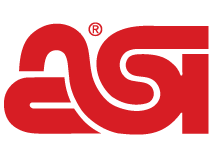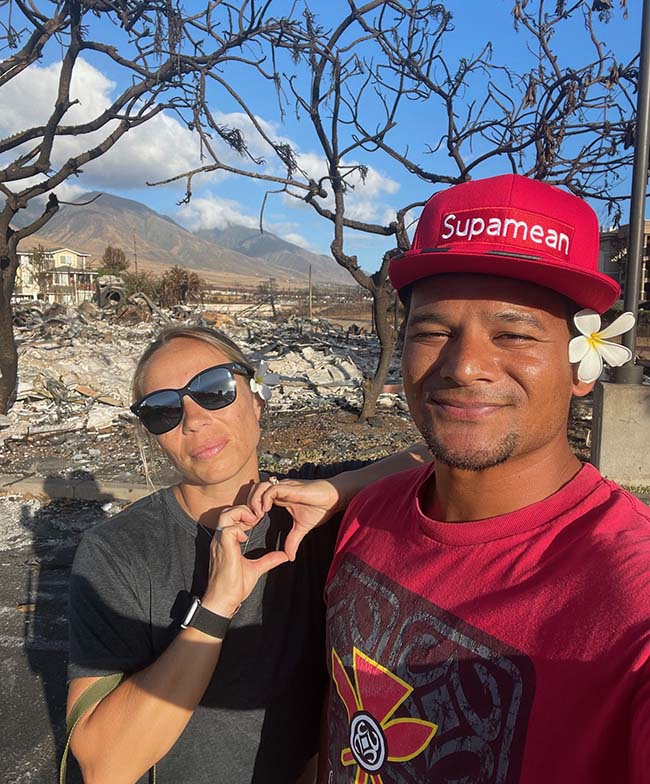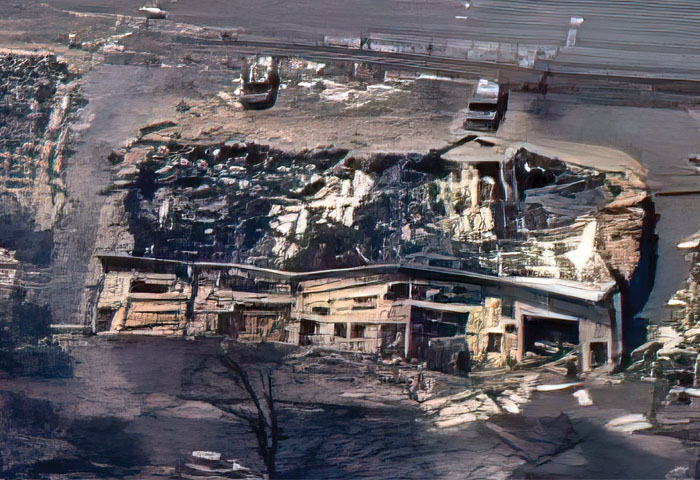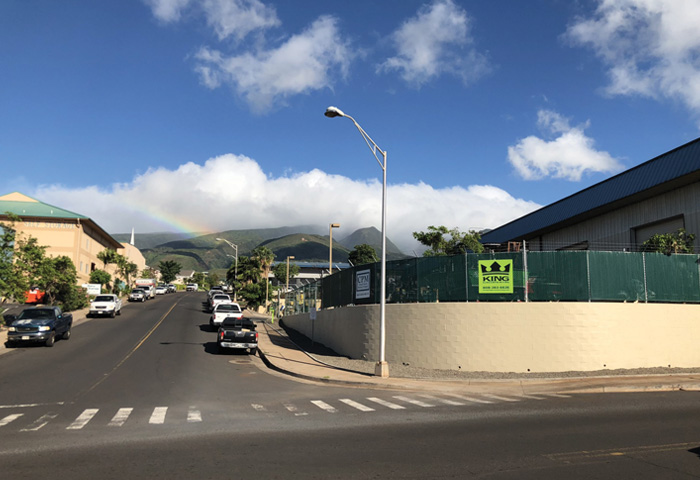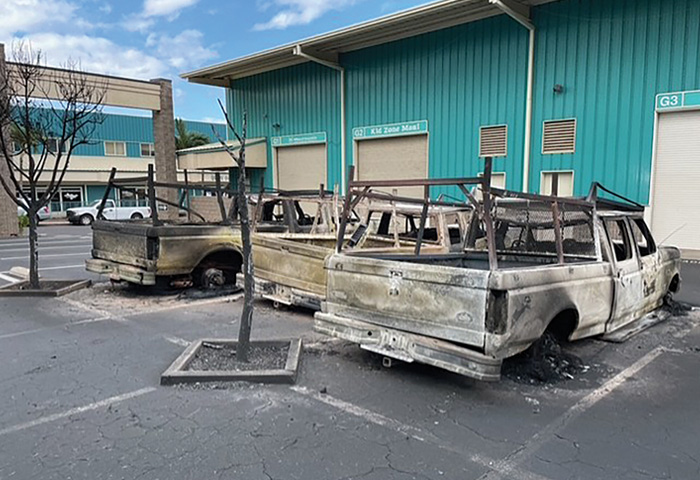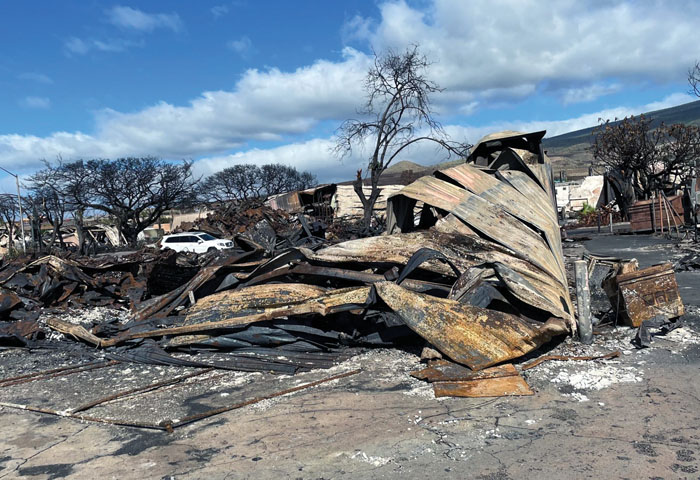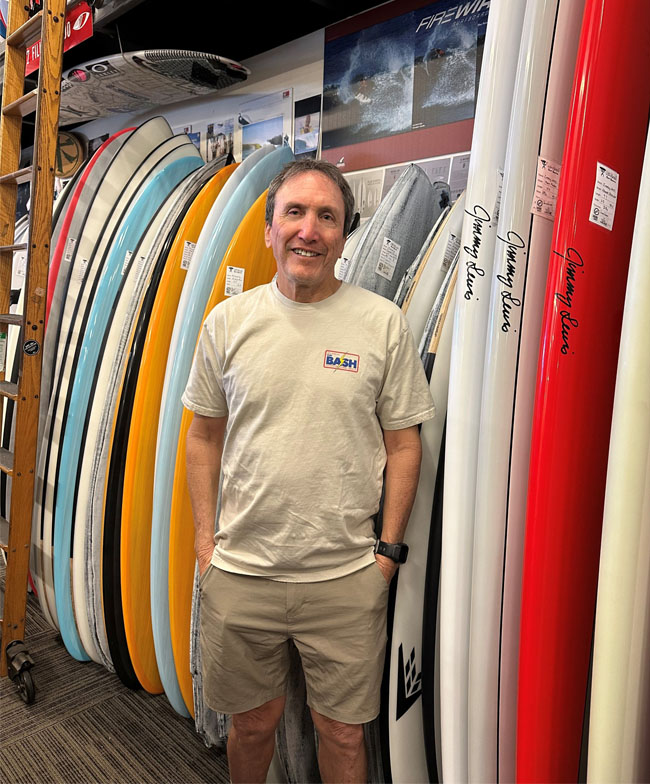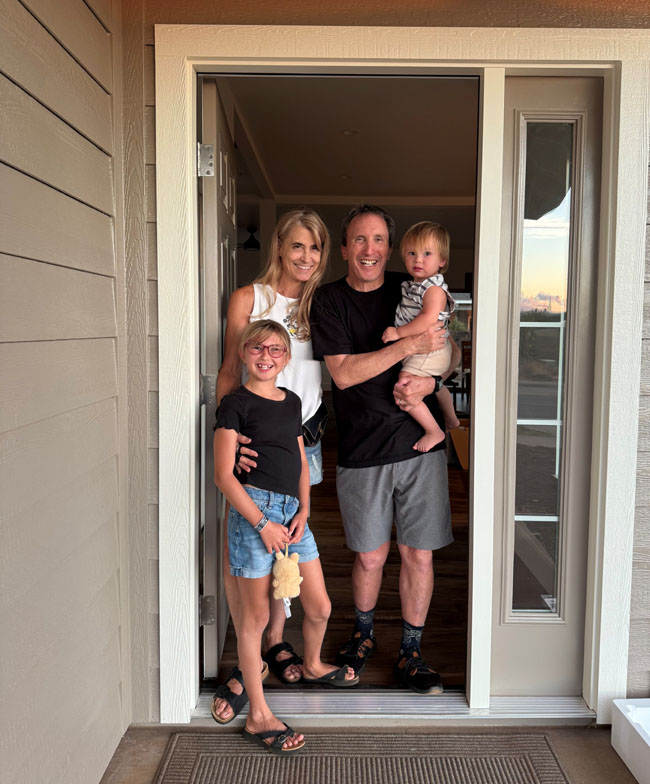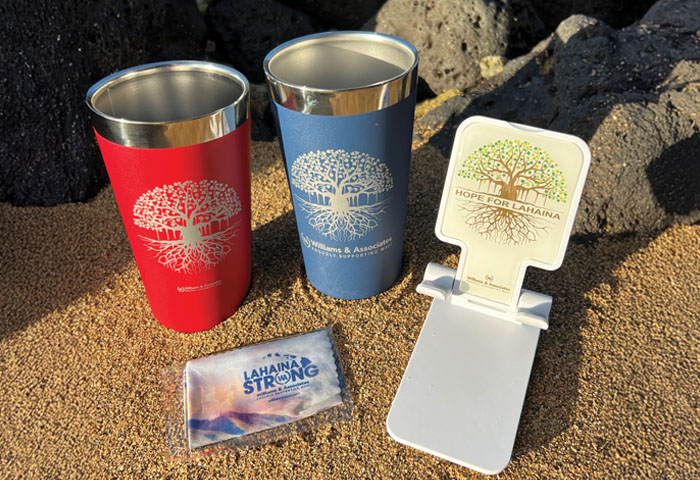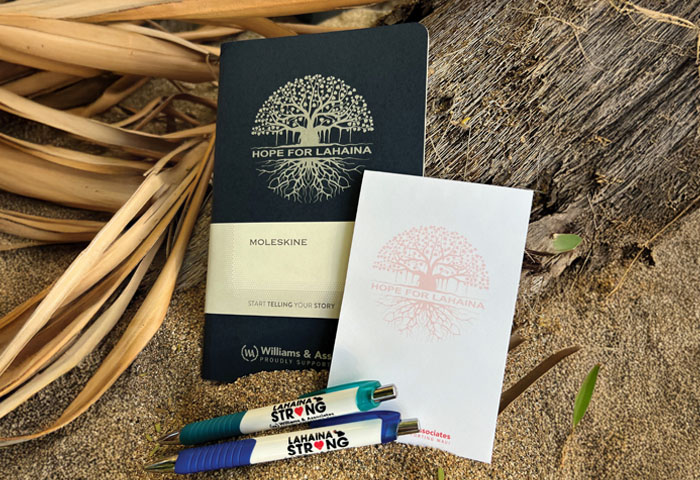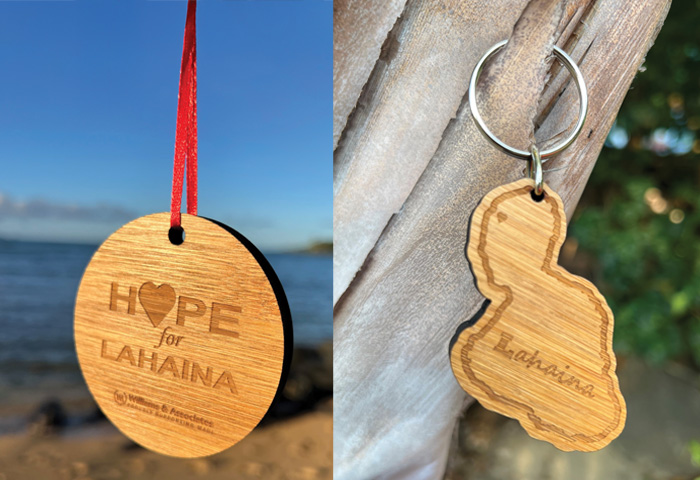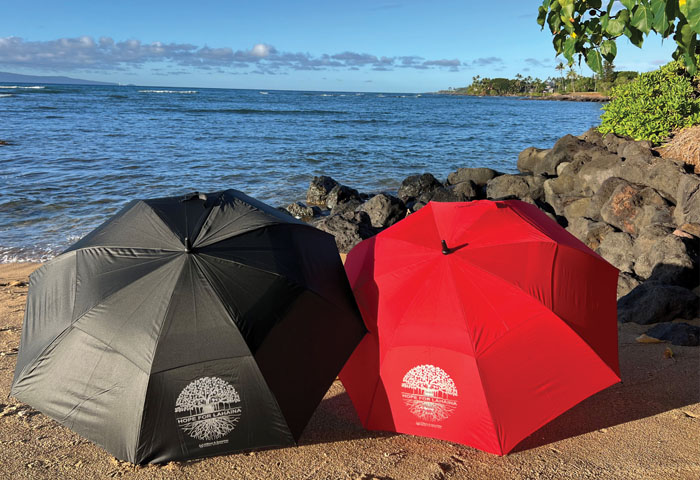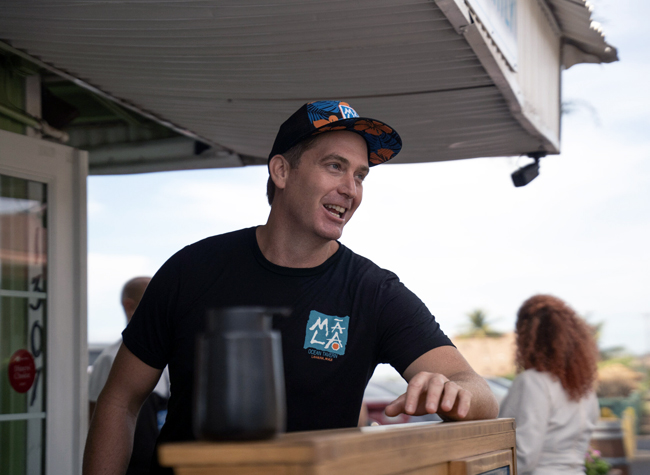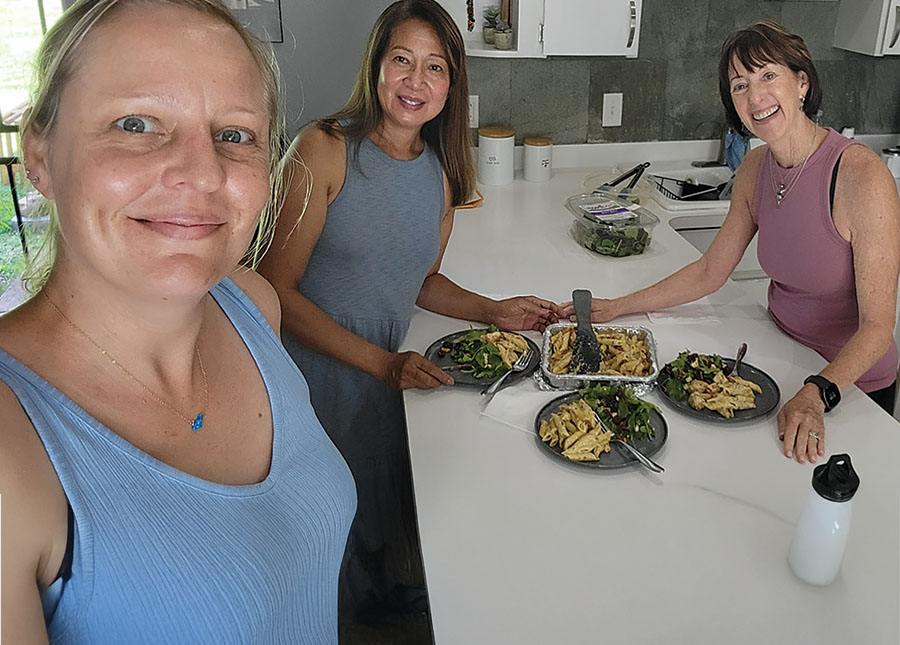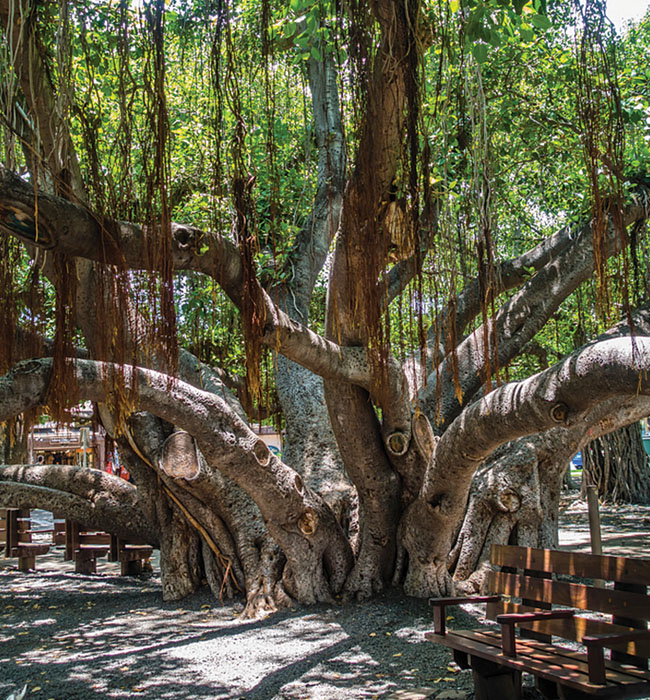On August 8, 2023, the power went out at 5:59 a.m., just as the last drip of coffee fell into Kim Williams Stiller’s mug.
At that moment, Williams Stiller was at the top of her professional game. Formerly a schoolteacher for 13 years, the Maui-based account executive at the 2016 Counselor Family Business of the Year, Williams & Associates (asi/360450), had joined the firm only after proving her commitment to her father, Bert Williams, in a formal interview. Her sales had climbed nearly 80% the year before, and just months earlier, she’d been named an ASI Media Distributor Salesperson of the Year finalist. Clients in hospitality and tourism raved about her persistence and kindness.
So, when the lights stayed out and the silence lingered, she refused to waste the day. Unable to work from her Kahana, HI, condo or her office in Lahaina 8 miles away, she and her husband loaded up the car with their dog to deliver products to clients across the west side of the island.
The trip was fraught from the start, with traffic at a near standstill and roads blocked by downed power poles and trees. It took four-and-a-half hours to drive what would normally take 15 minutes. Still, they pressed forward and reached their destination of Kahului, a town on the north central shore of the island. When they tried to go back, the road was closed. Williams Stiller (like thousands of island residents who received no emergency alerts that day) had no idea why. They sat in their car and waited.
During that time, one of her employees, Rowie Castro, was able to connect with her for exactly 90 seconds – a miracle, considering that all cell and radio communication in Lahaina was down – and said she had to evacuate her home. It was just enough time for Williams Stiller to give Castro the lockbox code to her condo – a stroke of fortune that allowed Castro, eight others, and a cat, a dog and a small goat to evacuate safely.
With no way back, Williams Stiller, her husband and their dog drove to her niece’s house in nearby Waikapu. There, she began piecing together the truth: A wildfire had swept through Lahaina. The damage was catastrophic. Shock overtook her. Miles away from the blaze, she was able to call another of her employees, Heather Ganis, who was in California taking her daughter to college. Ganis had no way to reach her family in Lahaina to know if they were safe. “We fell asleep on the phone, crying together,” Williams Stiller remembers.
The Lahaina wildfire was the worst natural disaster in Hawaii’s history. Two years later, families and businesses in this coastal Hawaii town are still struggling to recover, many left with no home to return to and no way to earn a living. The people who remain have worked tirelessly to help each other and rebuild Lahaina as they recover from the extreme physical damage and emotional toll wrought by the fires.
“After living through such a disaster, you never know what it’s like until it happens to you,” says Charlie Osborn, whose business Island Printing & Imaging (IPI) was destroyed by the Lahaina fire.
The road to recovery has been long and trying. From the ashes, print and promo professionals cleared debris and reshaped their businesses after their local clientele had been decimated. Still, from unimaginable hardship, something remarkable has emerged: hope.
Homes Destroyed, Businesses Gone, Lives Taken
As the residents of Lahaina went to sleep on Aug. 7, they did so in a town that was a vibrant, bustling coastal hub – a top destination for locals and visitors to the island of Maui. Nestled along the island’s northwest coast, Lahaina was anchored by historic Front Street, known for its lively arts and culture scene, oceanfront restaurants and distinctive art galleries. From Lahaina Harbor, travelers could embark on whale-watching excursions, snorkeling adventures, sailing trips, fishing tours and other ocean-based experiences. The former capital of the Hawaiian Kingdom (1820-1845) also offered several notable landmarks.
By the next evening, nearly all of historic Lahaina was gone – consumed by the deadliest U.S. wildfire in more than a century. The blaze claimed over 100 lives, left more than 10,000 people without homes, destroyed more than 2,200 structures and caused an estimated $5.5 billion in damage. Fanned by unusually high winds, it downed power lines, blocked roads and escape routes, and advanced faster than anyone could outrun. With emergency response nonexistent and radio and cell service knocked out, most residents had no warning until it was too late.
In the heart of the town’s creative scene, IPI was among the businesses wiped out in a matter of hours. IPI provided general printing, copying and scanning services, along with skilled graphic design and even fine art printing for artists and photographers on canvas, watercolor paper and photo papers. “We continually told people, ‘If it goes on paper, we have a solution,” says Osborn.
IPI was “a beloved fixture in the community, with many long-term customers,” Osborn offers. Located in the “old industrial park” of Lahaina, IPI shared the building with several other local businesses.
On Aug. 8, Osborn and his partner, Darice Machel McGuire, a fine art painter, tried to go to the shop, but with the power out and the wind howling, they returned home. They had no idea about the fire until the next day. “There was zero communication,” recalls Osborn. He got a call from a building mate asking if he knew anything about their building burning down. Just like that, their business was gone.
Picking Up the Pieces
Thousands of displaced residents struggled in those initial days to get their most basic needs met, such as housing and clothing. Meanwhile, others who were more fortunate still had to put their lives and careers back together.
Williams Stiller spent five days at her niece’s house, thankful to be alive but unable to get back and fearing the worst. “We didn’t know if we had a home or a business,” Williams Stiller recalls. “I assumed our building had been destroyed, and that I’d lost my career, which was devastating.” Ultimately, she learned that her building and showroom were still standing. “It was an emotional roller coaster, but I was grateful to know I still had a career to return to,” she says.
Williams Stiller quickly realized that her entire staff was impacted, and that they were wondering if they still had jobs. “That definitely motivated me to get back to it,” she says. Within about two weeks, Williams Stiller, Castro and Ganis – who lost her home and all her possessions – gathered in Williams Stiller’s small home office to regain their footing. “It was very stressful, and business was unstable, but it was good for us to be together,” Williams Stiller says. They worked in that improvised environment for about six months. In addition, Williams Stiller had to manage the insurance and restoration of her “minimally” damaged building. “I say ‘minimally,’” she remarks, “because while comparatively it was minimally damaged, the cost was still extreme.”
The wildfires had an immediate impact on Williams Stiller’s bottom line; her sales declined 70% in Q4 of 2023, and she finished the year down 25% despite being up the first three quarters. In 2024, sales declined 9% compared to all of 2023. “We’re still in recovery mode,” she notes. Thirteen percent of her clients closed due to the fire. Tourism in Maui has suffered as well, declining nearly 60% immediately afterward; in a 12-month period from August 2024 to July 2025, it’s down over 18% year over year.
“Our client base is traumatized and they’re short staffed,” says Williams Stiller. “They’re rebuilding their businesses and some have moved 10 to 12 times.” After navigating the wildfire fallout, she says she has a different perspective. “The industry and the nation need to know that we’re still in business, but it’s a lot of effort.”
Other promo and print companies faced similar daunting challenges. “Before the fires, we were cranking; business was growing,” says Rudi King, owner of Lahaina-based King Screen Printing. “We had come through COVID and were having some of our best years.”
Miraculously, King’s office and warehouse survived. “The fire started in the mountain above us, went to Front Street and then jumped over us,” he says. “One street over a steel building melted to the ground, but ours was intact aside from a lot of ash and debris that had to be cleaned up.”
Shut down for three months, King faced hurdles as he tried to reopen, with the National Guard station limiting access to “essential businesses only.” Persistent and resourceful, King designed orange long-sleeve workshirts with “a cool logo that said ‘Essential AF’” and managed to earn essential business status and get back to work.
Two years after the Lahaina wildfire, the promo industry recovery in Maui is ongoing. It’s been challenging for King, but, he says “We’re slowly coming out of it.”
“We lost a very large client pool that we had developed over the years,” he continues, “and are slowly rebuilding that base with new business as well as some old clients that are starting to relocate and rebuild after the fires.” Before the fires, King serviced clients on the west side of the island where Lahaina is located, but now he’s had to expand his scope and work harder to get clients on the other side of the island.
Because he’s doing less business with restaurants and retail stores, King has also had to switch up the types of merchandise he sells – selling more dry-fit shirts for outdoor-focused clientele like landscapers, construction companies and arborists.

“The industry and the nation need to know that we’re still in business, but it’s a lot of effort.”
Kim Williams Stiller, Willams & Associates (asi/360450)
Williams Stiller has pivoted into pursuing the demolition and construction industries, which are both strong sectors as the area starts to rebuild. She too had to expand her geographic footprint and is pursuing both off-island as well as mainland business. “I have adjusted my work schedule to reflect the needs of my clients and to be available when they’re ready to order,” she says, “whether they’re mainland clients in a different time zone, or resort clients, or food and beverage clients who are working evenings and/or weekends.”
Bound by Tragedy
Before the fire, Lahaina’s population was nearly 13,000 people, and everyone in the town knew someone who had died in the blaze. The disaster has brought people together, even as its scars surface in every conversation. Williams Stiller keeps in active contact with her clients who lost their careers due to the fires, out of concern for them but also to hopefully work together sometime in the future. She prioritizes conversations and empathy over business agendas. “Often when I meet with clients,” she says, “the first 30-45 minutes are spent listening intently to their evacuation story and their life situation post-fire.”
It’s not just clients who have had their lives profoundly changed. Among Williams Stiller’s team, two of her employees never returned full-time to work from the office, and of the remaining two, Ganis lost her home entirely and Castro’s was severely damaged.
Meanwhile, most of King’s employees are still displaced and living in state or federal accommodations, which he says has been a big concern. “Many people and friends have been discouraged by the lack of available rentals and work, and have simply moved off the island,” he notes.
Williams Stiller too is heartbroken by the exodus. “They were displaced with a housing crisis and needed to leave the island to simply find housing and stability for their families,” she notes.
That’s what happened with Osborn and IPI. “Once we knew the extent of the fire, it was clear there were no leasable buildings left standing, so the chances of re-establishing the business in West Maui were slim to none,” Osborn says. “Plus so many of our customers lost their homes, or businesses or both, so the viability of re-opening the business, even if we could, would be questionable.”
He and his partner made the decision to move back to northern California, where they’re both from. His business is now called Charlie Osborn Studio. He is focused on the art printing portion of the business, mostly for Maui artists. “It’s a limited version of what I used to do, because of ever increasing cost of shipping,” he says. His partner McGuire is working to re-establish herself on the mainland after having lost 50 years of collected paintings and ones she created.
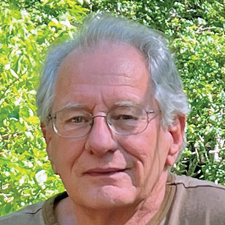
“After living through such a disaster, you never know what it’s like until it happens to you.”
Charlie Osborn, Island Printing & Imaging/Charles Osborn Studio
For those who remain, the challenges are felt in ways big and small. The internet works but could be slow, or the electricity might be spotty. “We now have constant alarms and alerts from Hawaiian Electric Company (HECO) threatening to shut off power for high wind conditions,” says Williams Stiller. (The fire is believed to have started from broken power lines that sent sparks to overgrown brush, and there have been multiple lawsuits filed against the power company, citing negligence and failing to cut power to the lines during the high winds and fires.)
For those who survived the disaster, anything – the smell of a campfire, watching the evening news – can be a trigger. While the alerts add to the post-traumatic stress so many are still experiencing, they’re a necessity to prevent a similar disaster, and “a reminder that we hope that devastation never happens again,” says Williams Stiller.
But amid all the heartbreak, the people of Lahaina are doing what they can do to support each other and revive the town. For a year after the blaze, King’s company offered a special discount to anyone affected by the fire.
Adds Williams Stiller, “We support any inquiry for promotional products, big or small, with a limited gross margin to support the revival of our town.” Every self-promo she produces is centered around restoring her beloved town, featuring “messages of hope and restoration to improve morale.” Local businesses that survived the fires are continually helping the community with fundraisers and services, she adds. Promo suppliers too donated money and goods and extended favors to help distributors like Williams Stiller get back on their feet.
The spirit of collaboration and aiding one another is strong. King and Williams Stiller, for example, help each other with projects. “Rudi is a friendly competitor of mine,” she says. “We refer business to each other, and he’s currently printing a job for one of my clients.”

“Many people and friends have been discouraged by the lack of available rentals and work, and have simply moved off the island.”
Rudi King, King Screen Printing
In the meantime, millions of others can help by visiting the island and supporting local businesses. Tourism, directly or indirectly, was the primary driver of Maui’s economy before the fires, contributing some 70% of every dollar on the island. Parts of Lahaina – including Front Street, the town’s historic banyan tree, and the harbor – remain closed to the public as clean-up efforts continue. But restaurants, businesses and activities in Lahaina are open and welcoming visitors – as are resorts and restaurants all across Maui’s 727.2 square miles. “Maui is not closed,” says Kim Ball, a longtime Lahaina resident and owner of Hi-Tech Surf Sports, a Maui institution with five locations. “Tourism drives our economy and we need people to come back.”
On Aug. 8 this year, like last year, Williams Stiller closed the office to allow her employees to spend the day however they wanted. She had planned to volunteer at a preschool run by a friend that she visited on the day of the fire. Instead, car troubles landed her at the dealer (a client of hers), where she “shared a few stories and some tears in the middle of the day” with the service manager. The day, she says, “was somber. Many businesses were closed and there was a heaviness in the air everywhere you went.” It didn’t help that the west side of the island had two evacuation warnings in the 10 days prior, including a tsunami alert.
Two years after the devastation, she recognized how much she had changed. She had always been goal oriented, a list maker. Now, she’s less concerned about crossing off every item. “When there’s an opportunity to listen to a neighbor, friend or client,” she says, “I’ll prioritize that over finishing a task or closing a sale.” The fire transformed everything, but it also deepened her sense of what matters most.
